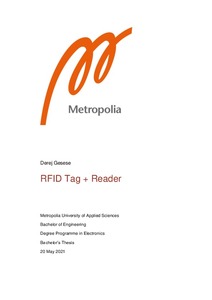RFID Tag + Reader
Gesese, Derej (2021)
Gesese, Derej
2021
All rights reserved. This publication is copyrighted. You may download, display and print it for Your own personal use. Commercial use is prohibited.
Julkaisun pysyvä osoite on
https://urn.fi/URN:NBN:fi:amk-2021060113093
https://urn.fi/URN:NBN:fi:amk-2021060113093
Tiivistelmä
This thesis focuses on the development of a prototype RFID system project using 13.56MHz frequency band and a passive RFID system. This RFID thesis aims to give an understanding of the operation about the RFID technology communication system and all the processes involved. The prototype project includes the designing of RFID system, and the results are as expected and in line with what the available theory shows.
The first part of this RFID Project Prototype report describes the basic physical concepts governing the overall functioning of RFID identification system especially inductive coupling, which defines the communication between RFID Tag and Reader. The second part of the report details the various RFID system application areas starting from the basic functions to different important industries. Many countries in the world are implementing the above functions of RFID identification. In the third part of the report, the RFID Prototype Project was developed using MFRC-522 13.56 MHz RFID reader and a photon programmed with a code. This RFID Project Prototype has achieved its goals when the developed Prototype showed a green LED light for allowed Smart Cards and red LED light for non-permitted Smart Cards. The Project read the RFID tag ID and display it on a computer screen, check the white list and give or deny Access to the tag requesting access.
This project was developed as an access control system Guest Houses in Addis Ababa, Ethiopia. It is possible to develop the RFID Prototype Project to an even advanced level by incorporating various simulation schemes and software, which can ease the building of a prototype RFID system. The use of control points and computer monitor can improve the observation of results. The future RFID research students can use more resourceful techniques in the making of the prototype and they can gather more optional resources to practice as many designs as possible available in the electronics industry.
The first part of this RFID Project Prototype report describes the basic physical concepts governing the overall functioning of RFID identification system especially inductive coupling, which defines the communication between RFID Tag and Reader. The second part of the report details the various RFID system application areas starting from the basic functions to different important industries. Many countries in the world are implementing the above functions of RFID identification. In the third part of the report, the RFID Prototype Project was developed using MFRC-522 13.56 MHz RFID reader and a photon programmed with a code. This RFID Project Prototype has achieved its goals when the developed Prototype showed a green LED light for allowed Smart Cards and red LED light for non-permitted Smart Cards. The Project read the RFID tag ID and display it on a computer screen, check the white list and give or deny Access to the tag requesting access.
This project was developed as an access control system Guest Houses in Addis Ababa, Ethiopia. It is possible to develop the RFID Prototype Project to an even advanced level by incorporating various simulation schemes and software, which can ease the building of a prototype RFID system. The use of control points and computer monitor can improve the observation of results. The future RFID research students can use more resourceful techniques in the making of the prototype and they can gather more optional resources to practice as many designs as possible available in the electronics industry.
